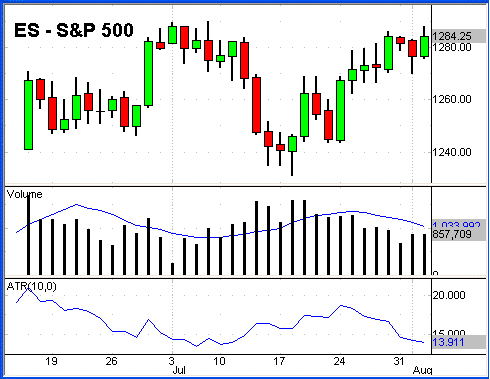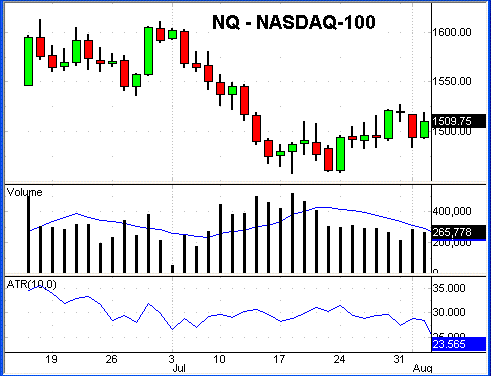If I Could Trade Only One E-Mini Strategy, This Would Be It
E-mini futures are a phenomenal financial instrument with which to day trade
the stock market. E-minis are transparent, liquid, and cheap, which is why so
many retail traders are trading them. In this article, I’ll detail the
characteristics of the more popular e-minis and show you how to use them with
three simple daytrading approaches.
The Chicago Mercantile Exchange (CME)
introduced mini-sized versions of the S&P 500 and NASDAQ-100 futures in the late
’90s. These mini-sized contracts were not only smaller in size, tick values, and
margin requirements, they were also traded electronically…and that’s where the
term ‘e-mini’ comes from. But nowadays, with gold, oil, and other small
contracts trading on the screens, the term ‘e-mini’ is used in trading circles
to describe a whole host of electronically traded contracts.
The S&P 500 (ES) and NASDAQ-100 (NQ) remain among the most popular e-minis.
Also included are the Russell 2000 (ER) and Dow Jones Industrial Average (YM).
The ER e-mini, like the ES and NQ, trades on the CME, while the YM trades on the
Chicago Board of Trade (CBOT). These four
e-mini contracts, based on the most closely-watched U.S. equity index averages,
are among the most popular choices for day trading. Other mini futures contracts
are catching on, however, such as the aforementioned gold and oil mini futures.
ES ($50 per point)
The popularity of the indices e-minis stems from the massive liquidity that
is available. The ES routinely trades over 1 million contracts per day during
regular trading hours, and a couple hundred thousand contracts during the
overnight session. To put this into perspective, you can very easily buy or sell
500 ES contracts during the day, which amounts to about $30,000,000 worth of
futures. Trades of 500, even 1000 contracts clear all day long, without
adversely impacting the bid/ask spread.
Each point in the ES is worth $50, so if you buy one contract at 1280.00 and
it goes to 1284.00, you’ve made $200 ($50 x 4 = $200). (The 500 lot trader would
clear $100,000 on four points!) The minimum fluctuation of the ES is 0.25
points, which makes each tick worth $12.50.
To learn more about the contract specifications for the ES, including margin
requirements, you can visit the
ES overview
page on the CME’s web site.
The daily chart below of the ES includes the volume, 10-day average volume,
and the 10-day Average True Range (ATR). I’ve included the ATR, which is a basic
measure of volatility, to reveal the dollar potential of the contract. The ATR,
although imperfect, will give us an idea of how much profit potential the ES is
trading with. The way I look at it is like this: The ATR is at about 14, and
each one of those 14 points is worth $50 per contract, so there’s about $700 per
contract in dollar movement going on in the ES.

Source: Quote.com
NQ ($20 Per Point)
The ES is the most popular of the e-minis based on trading volume. Coming in
second is the NQ, which trades about one-quarter the volume of the ES each day.
The NQ is different in other ways, too, such as its minimum tick value and daily
volatility. Each point in the NQ is worth $20, and like the ES, the NQ trades in
quarter point increments. Each tick in the NQ, therefore, is worth $5 per
contract.
The daily fluctuations of the NQ are much larger than the ES. Perhaps that
stems from the fact that there are 400 fewer stocks in the underlying index of
the NQ, and that most of those underlying equities are volatile tech stocks.
Whatever the reason, the NQ averages about 25 points per day based on the 10-day
ATR. That gives the NQ about $500 (25 x $20) of movement per day, per contract.
To learn more about the contract specifications for the NQ, including margin
requirements, you can visit the
NQ overview
page on the CME’s web site.

Source: Quote.com
ER ($100 Per Point)
Coming in third place among the equity indices and based simply on daily
volume totals, is the ER. About 150,000 contracts change hands every day. But of
the the four indices, the ER offers the most dollar potential on an intraday
basis. The big movement of the ER and its comparatively high tick value, are the
reasons why I focus primarily on this contract in my own trading.
Each point in the ER is worth $100, and the contract trades in $0.10
increments, so each tick is worth $10 per contract. But here’s where it gets
interesting: The 10-day ATR is about 13; therefore, each day there’s about $1300
of profit potential ($100 x 13). The profit potential in the ER dwarfs that
available in the ES and NQ. But with that increased volatility comes greater
risk. That’s why the ER is probably not the best contract to start day trading
with, especially for beginners new to the futures market. The slower moving
contracts like the ES or NQ are better places to begin learning how to day trade
with e-mini futures.
To learn more about the contract specifications for the ER, including margin
requirements, you can visit the
ER
overview page on the CME’s web site.

Source: Quote.com
YM ($5 Per Point)
The fourth and final equity index e-mini that we’ll take a look at is the YM,
based on Dow Jones Industrial Average. The YM trades about 100,000 contracts per
day, making it the least popular of the four contracts. I don’t know exactly why
the YM hasn’t caught on more with traders. After all, it’s based on the Dow,
which is much more visible and popular than the Russell 2000, for example.
Perhaps the lower trading volume is a reflection of traders’ preference for the
CME’s trading platform, Globex, over that of the CBOT’s electronic equivalent.
Each point in the YM is worth $5, and the contract trades in one-point
increments. If you bought one contract at 11225 and sold it at 11235, you would
net ten points and make $50 ($5 x 10). The 10-day ATR for the YM is at 119,
giving the contract about $600 of potential each day. As you can see, the dollar
volatility of the YM is similar to the figures for the ES and NQ.
To learn more about the contract specifications for the YM, including margin
requirements, you can visit the
YM product
overview on the CBOT’s web site. If you explore the CBOT site, you will find
an extensive listing of other futures contracts, including several different Dow
Jones Industrial contracts that are worth $10 and $25 per point.

Source: Quote.com
The reason that I’ve gone through explaining the different characteristics of
each equity index e-mini is to help you decide which contract best fits with
your trading style, risk tolerance, and account equity. But you don’t
necessarily have to choose one contract and only trade it. The argument for
trading all four equity index e-minis is that from day to day, one will be over-
or under-performing the others.
I’m sure you’ve noticed that on some days small caps out perform large caps,
which would make the ER a better buy than the YM on that particular day. This
phenomenon is referred to as relative strength, and it plays out every day in
the market. If the day has an overall upward bias, it would make sense to buy
the e-mini that is trading the strongest. Conversely, if the overall trend of
the day is downward, then it would make the most sense to short the contract
that is trading the weakest.
If you are going to monitor and trade all four equity index e-minis, then you
can follow a few simple steps each day when deciding on which contract to trade.
1. Define the day’s trend. This can be done through casual observation such
as assessing the day’s change from yesterday’s close, or defined with indicators
or quantitative analysis. However you do it, define the trend of the day as up
or down.
2. Buy the contract that is trading the strongest, i.e. biggest percentage
gain for the day, if the market is in an upward trend.
3. Sell the contract that is trading the weakest, i.e. biggest percent loss
for the day, if the market is in a downward trend.
4. Cut losses short with a technically-based stop loss in the event that the
day’s trend reverses.
5. Let profits run.
Monitoring all four contracts does require more attention and possibly
additional technology resources such as multiple monitors. But daytrading the
e-minis can be made simpler by following just one of the contracts. As I wrote
earlier, I primarily trade the ER because, dollar for dollar, it has the biggest
swings of the four futures. But that may not make the ER right for you,
especially if you’re just getting started with trading the e-minis. One of the
slower moving contracts, in fact, might be a better choice for beginners.
Further, I’m not trading with a multi-million dollar account, so I can afford to
be a little more nimble with my entries and exits; I don’t need the liquidity of
the ES or NQ. I can move 20 contracts in the ER pretty easily, without adversely
impacting the bid and ask. If I were trading 100 or 200 contracts at a time,
however, then I would instead use the ES or NQ.
We’ll be going into more detail into different trading strategies for the
E-Minis, but this should serve as a good general introduction. Good luck, and
see you soon!
Eric Utley is a full-time trader with over a decade of experience in
equities, equity options, futures, and currencies. He specializes in trading
currencies, using a combination of quantitative, technical, and fundamental
analysis. Eric also regularly day trades the e-minis, with emphasis on the
Russell 2000 (ER). He is the lead contributor to
INVESToolsCT.com, manages a
currency trading blog, produces educational programs, and hosts a weekly online
seminar.
